Now & New
Omoto Shrine Momote Festival: Miyajima’s Beauty Even in Rain
While Miyajima may attract tourists year-round, there’s no disputing that spring, summer, and autumn all see on average more tourists than winter does. Not only are the colder temperatures unpleasant to a lot of tourists, but cold combined with rain or snow can make activities like hiking Mount Misen or even walking around town a little dangerous. However, if there’s one factor drawing visitors to the famed Shrine Island in the frigid month of January, it would be the New Year itself, especially considering how sites like Itsukushima and Omoto Shrine hold plenty of events around this time. Some folks also like to climb Mount Misen as close to New Year’s Day, with some even timing their visit to the summit with the first sunrise of the year.
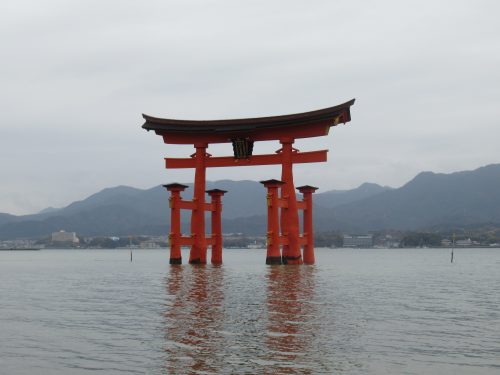
I just so happened to be out of the country on the days following the 1st of January, so I couldn’t catch any of the cool ceremonies going on at Itsukushima Shrine. The next festival I was able to make was the Momote Festival held at Omoto Shrine, a site I rarely hit up, even when hiking. It was held on Saturday, the 20th of January, and although I knew it would be a dreary, rainy day, I was determined to witness a never-before-seen event so close to my Home Sweet Hiroshima.
Lost in Town, Shrine Then Found

You would think that after having visited this island so many times that I would know all its streets like the back of my hand, but alas, even a Hiroshima veteran like me can still be prone to mistakes. I checked the walking route from Miyajima Pier to Omoto Shrine on my smartphone’s map application to find the fastest way to the festival site, but shortcuts are often more complicated than the straight path everyone knows. My so-called shortcut took me through the sparsely populated Machiya Shopping Street where I doubted myself and referred back to the map several times, but for what it’s worth, I got myself a sweet shot of the five-storied pagoda from where I was.

I eventually reoriented myself and made a beeline for Omoto Park, but I was disappointed in how long that took me. On my way there, I saw a bunch of deer resting in the open without so much as a care for the rain; the one pictured above seemed to be giving me the look, as if it was surprised at my lack of sense of direction. I may have arrived later than anticipated, but at the least, I wasn’t too late for the good part of the ceremony. I had read about archery being involved, and you definitely don’t see that at every shrine festival.
Shooting Heaven, Earth, and a Target
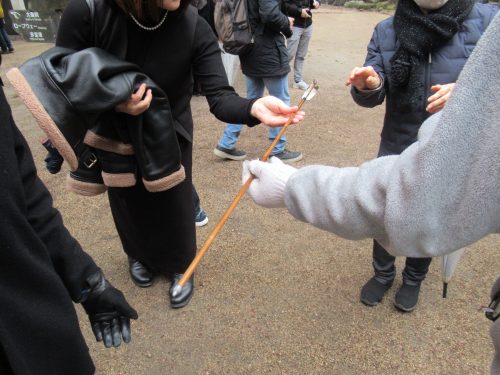
When I got to Omoto Shrine, the priests inside were already delivering offerings to the tutelary god inside and saying prayers, but that ‘s kind of boring stuff. Once that ended, they came out, with one priest holding a bow while another held an umbrella over him. The ritual involved many intricate steps, including firing an arrow into the sky (he shot at a high tree branch instead) and onto the ground (he made the arrow slide rather than impale the dirt) before aiming at the target. He shot quite a few arrows, but only two hit the mark.
Afterwards, the rope barrier was taken down and we viewers were allowed to touch one of the arrows used in the ritual and approach the target at which the priest shot. Only two arrows piercing the target doesn’t sound so impressive on the surface, but between the type of bow, the archer’s outfit, and the undesirable weather, we couldn’t place too much blame on the man himself. Next to where I stood watching, there was a bonfire and a stand selling lucky charms, but since I’m neither a collector nor the superstitious type, I left Omoto Park and went straight to Omotesando for lunch.
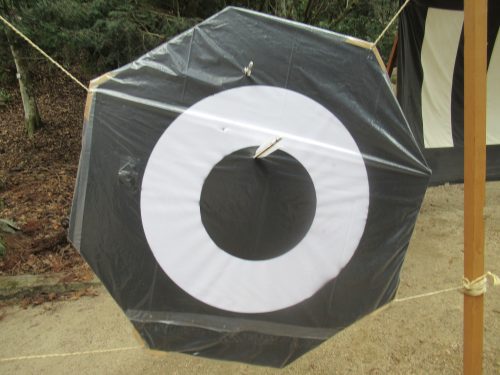
Famous Eats on Shopping Streets
Before I even departed for Miyajima that day, I already knew where I wanted to grab lunch: Kakiya (牡蠣屋), a seemingly internationally renowned restaurant and bar specializing in oyster cuisine. Kakiya is situated on the good old Omotesando shopping street, but since that one stretch is saturated with stores and people every day of the week, the restaurant I was looking for was kind of difficult to locate. It has an inconspicuous sign so I passed it several times while looking for it on my smartphone’s map app; I stopped in front of a store right across from Kakiya trying to get my bearings, and the lady inside shooed me away in the direction of the restaurant.

I was expecting a longer line and a bigger sign with lots of English, considering how many tourists from abroad want to eat here. Diners first place their order from the multilingual vending machine, and after paying, the machine prints out a ticket that they hand to a woman who rips off the stubs and hands the tickets back to the diners. At first, I was a bit conflicted as to what to order, but this detailed diagram of the Kakiya set meal sealed the deal. A spread like this must have been responsible for having Kakiya featured in the Michelin guidebook for the Hiroshima area.
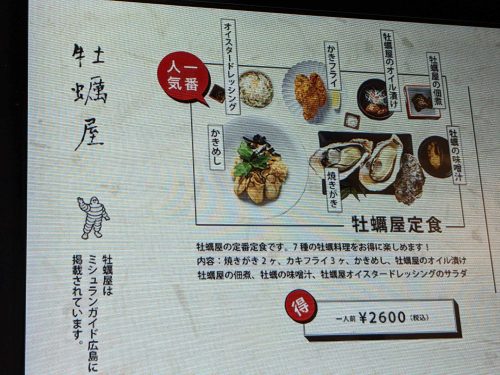
After getting my ticket back from the woman by the vending machines, I sat down at the counter where I whittled the time away watching the servers bring food to other customers. When my meal finally came, I was delighted to see everything the diagram mentioned, but better-looking! For starters, there was oyster miso soup and a green salad with an oyster dressing, which I failed to notice until after finishing the salad so I drank the dressing straight up. The main course came in several forms: kakimeshi (cooked oysters on rice), three deep-fried oysters with a lemon wedge and tartar sauce, one oyster pickled in chili oil, and two grilled oysters on the shell (which came later). Last but not least, there was a tiny square dish filled with “Kakiya’s tsukudani,” which is just shredded seaweed boiled in a sweetened soy sauce and probably tiny traces of oyster. It took a while to finish all this food, and even after I was done, Kakiya’s interior had this ambience that made me want to stay, slowly sipping water while employees dashed back and forth, occasionally refilling my water glass and prolonging my stay.
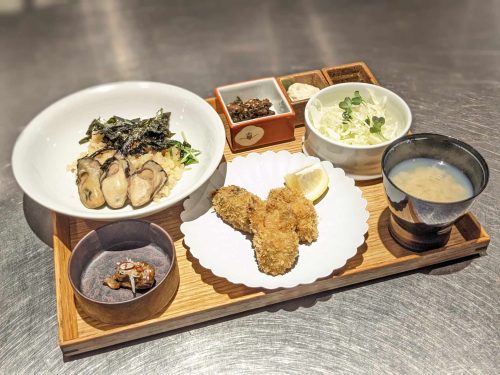
Eventually, I mustered the energy to leave the restaurant and hunt down the next eatery for dessert: Katsutani Snack Bread Shop. This bakery specializes in sweet sandwiches with filling such as their classic mashed red bean and butter, strawberry jam, or chocolate and banana, but they also have some savory sandwiches like hot dogs or yakisoba buns. Since I was still full from all the oyster entrées I had just ingested, I went for the simplest item on the menu: a mashed red bean sandwich without butter. It took a couple minutes for me to get my food because it was made to order, but the bread was warm when the lady handed it to me, so the wait was worth it. There’s a single bench next to the store where customers can sit and eat their bread (most people eat while standing or walking anyway), but as the bench was occupied, I went ahead with a culinary photoshoot until the space freed up.
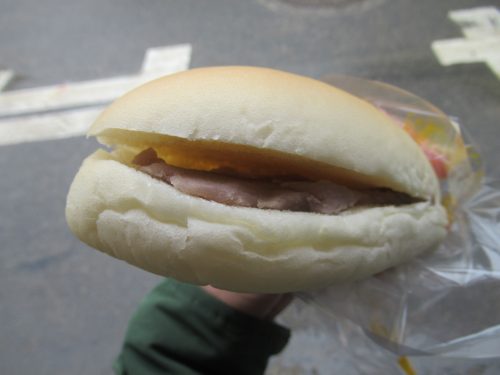
Moment of Joy: Target of Envy
Sitting on the bench also meant being able to eat while hiding from the rain, which was on and off in the afternoon. As I tore through my sandwich, passersby of all ages—mostly students—gazed upon me and my food with envy, wishing out loud that they could be sitting where I was and enjoying a hot, fluffy piece of bread. Normally, I would be opposed to the idea of being used as free advertising for any business, but given the great taste of my sandwich and the looks of admiration from the stream of people, I was flattered to know that the sight of me chowing down may have helped the Katsutani Snack Bread Shop sell more. I conscientiously tried to make this moment of joy last as long as it could as I savored my food.
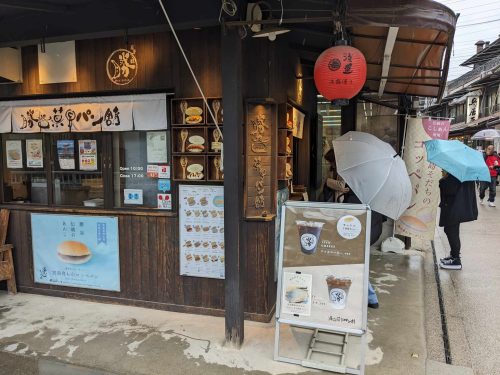
Rise and Shrine
After my two gastronomic pit stops, it was time to check out the typical tourist sites of Miyajima, starting with the grounds of Itsukushima Shrine. When I got there, the tide was rising, but there was still a margin of space at sea level for walking. Lots of people were gathered at the usual vantage points to photograph the submerged torii gate and resident deer, which were conveniently standing in picture-perfect poses. I got this snapshot of one deer next to the maple leaf-shaped plaque that commemorated the date of my visit to Miyajima: January 20th, 2024.

I then went down the steps to walk on the sand where the tide was gradually encroaching, making sure not to get my shoes wet. The tide at Itsukushima Shrine rises and falls more swiftly than one would expect; I thought I had ample space for walking when I first descended, but on my way back I had to hop from one dry spot to another. Compound that with the bed of slippery, green algae where people ought not step, and I found the area of dry sand at sea severely limited. I got my pics and hurried back up the staircase from whence I came, taking care not to go too fast lest the muddy soles of my shoes make me slip.

With the tide on its way up, I also found myself ascending further to the five-storied pagoda I saw this morning, as that area is a lovely photo spot that doesn’t cost a single yen to enjoy. Ironically, the pagoda is harder to photograph the closer one gets to it, so I backed up a little bit by moving over to the adjacent Senjokaku and squatting to get a good look at it. One can even go further, like down some stairs to the To-no-Oka Teahouse (塔之岡茶屋), where tourists can get a neat view of the five-storied pagoda while sipping hot tea and enjoying sweets like warabimochi (bracken starch dumplings covered in kinako, or sweet soybean flour) or zenzai (hot, sweet red bean soup served with some sour, candied seaweed strips). I also frequent this café from time to time for a moment of calm respite, as the nearby pagoda and Senjokaku are indeed classic tourist sites, but never as crowded as the area surrounding Itsukushima Shrine. If not for my already full tummy, I would have definitely had a snack here.
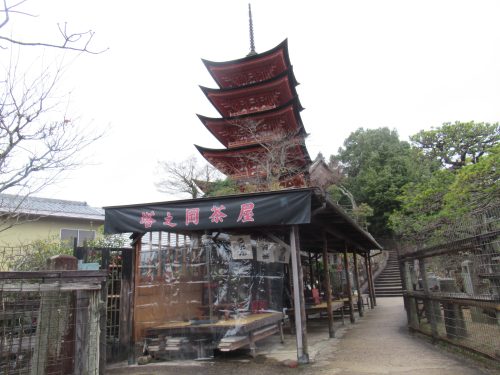
The last point of interest I checked out that day was this oddly formed tree to the right of the above teahouse: the Dragon Whisker Pine. This tree was estimated to have been planted in the year 1800 CE, and when it started growing horizontally, the lopsided trunk was propped up and the tree continued to lengthen year and year, until it reached its current state, long as a dragon’s whisker. If not for the sign explaining its name and history, most tourists would whiz past it in favor of the five-storied pagoda, but this beast of plant is best appreciated from the outdoor seating area of the To-no-Oka Teahouse.

Winter may appear to be a gloomy season for a majority of Japan’s tourist sites, but in spite of the gray, rainy skies, I had a fun, beautiful day on Miyajima. To compensate for the lack of flowers or autumn leaves, try timing your visit with days when Itsukushima Shrine or any other shrine on Miyajima holds some sort of ceremony. Check Miyajima tourism websites as well as the pages of individuals shrines and temples for the most accurate, up-to-date information, even if it’s only in Japanese. Being able to witness the subtle wonder of the auspicious archery involved in Omoto Shrine’s Momote Festival has reminded me how much of Miyajima’s undiscovered traditions are still living under my nose. You can bet I’ll be back again next January closer to New Year’s Day, and maybe I’ll give that icy cold Misen hike a try, weather permitting!
Written by the Joy in Hiroshima Team
